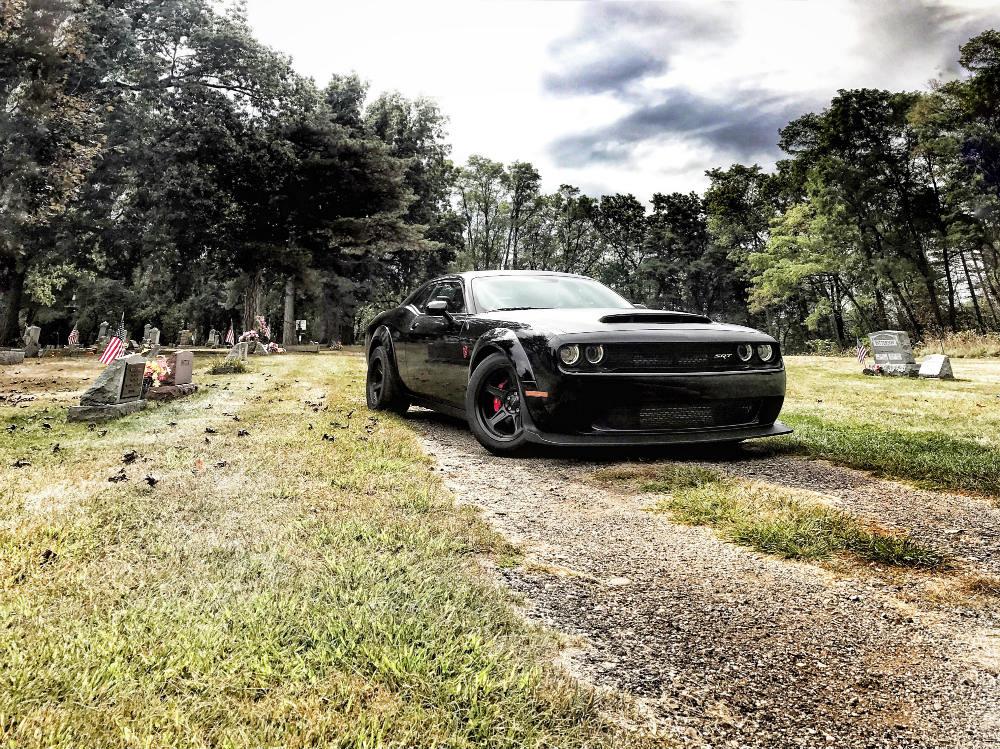Owner, Brown Dog Welding
- FMA
- The Fabricator
- FABTECH
- Canadian Metalworking
Categories
- Additive Manufacturing
- Aluminum Welding
- Arc Welding
- Assembly and Joining
- Automation and Robotics
- Bending and Forming
- Consumables
- Cutting and Weld Prep
- Electric Vehicles
- En Español
- Finishing
- Hydroforming
- Laser Cutting
- Laser Welding
- Machining
- Manufacturing Software
- Materials Handling
- Metals/Materials
- Oxyfuel Cutting
- Plasma Cutting
- Power Tools
- Punching and Other Holemaking
- Roll Forming
- Safety
- Sawing
- Shearing
- Shop Management
- Testing and Measuring
- Tube and Pipe Fabrication
- Tube and Pipe Production
- Waterjet Cutting
Industry Directory
Webcasts
Podcasts
FAB 40
Advertise
Subscribe
Account Login
Search
From burning metal to burning rubber
- By Josh Welton
- November 28, 2017
The head sock doesn’t quite stay in place as I pull the helmet down over my unkempt hair and press it past my ears. “Whatever,” I think. “I can see what’s in front of me.” Nothing else matters, at least according to the little red devil perched on my shoulder. “Just fasten the chinstrap, kid.”
There is no angel.
Double check the center screen and yup, the Challenger is in Drag Mode. Keeping one eye on the track and the other on the official’s gesturing, we lumber up to the burnout box. The tach is hovering barely above idle as the front skinnies glide through the water and the ginormous rear drag radials come to a rest in the shallow pool. Wrapping my left hand around that side of the steering wheel, I squeeze and hold the “OK” button with my thumb, and Line Lock is activated. As my left foot comes up off the brake and right foot presses down on the gas, the engine howls up towards 4,000 RPM and the rear rubbers smoke in unison. One second, two seconds, three seconds … release the thumb and come off the throttle gently while the car lurches forward.
With the Nittos sufficiently cleaned of debris and warmed up for grip, I get the tech’s affirmative nod to proceed. We get the car straight, in the groove, and up to the starting line. The tree is triggered, and its lights flick on and off progressively downward until the bottom yellows stay lit. My hands pull back on both shift paddles, engaging the transbrake as I tip the throttle to 1,700 RPM and hold it while lifting my left foot off the brake. All slack is removed from the driveline as 8 lbs of boosted air, cooled by diverted A/C refrigerant, builds up in the blower while fuel and spark adjust to keep the engine balanced. The exhaust explodes in a staccato popping, the Demon a straining, snorting bull ready to burst out of a bucking chute. Left hand lets go, right hand follows suit, and potential energy converts to kinetic in one instant of beautifully orchestrated violence. The rear squats, the front lifts, and it’s wide-open throttle until you see God. Which happens about 9 seconds later when you catch the 1,320-ft. mark right before crossing it at 135+ MPH. Lift, brake, and try to wipe the Jokeresque grin off your face before doing it all again.
Rewind to the previous night as Darla and I left Detroit and headed west towards the US 131 Motorsports Park in Martin, Mich. It was a beautiful early fall evening, the kind where pictures do no justice, and as we cruised through the rural country near where I grew up, my thoughts drifted back almost a decade and a half. In my brain, the year was 2003: I was a few months into my millwright apprenticeship at Chrysler, starting to cash some decent paychecks, and getting the urge to go fast.
I was looking for a street car, something that would more than hold its own in A stoplight fight but could still be driven every day. To keep things in perspective, at the time GM was building a Corvette putting out 405 HP, and the big news was Dodge’s Viper hitting the 500-HP mark. Neither sports car was in my price range; besides that, I had eyes for something a bit older and more muscular.
Word spread quickly throughout the factory about what I wanted, and soon a contractor searched me out. He worked for Pico, a company that engineered conveyor systems and was in our facilities helping install a system. He said his brother had a 1968 Dodge Dart for sale. It was far from stock, a hot rod with a brand-new paint job, a fresh big block built for war, and his brother drove it on the street “all summer long.” For some reason this brother had to leave the country ASAP and needed to move the car quickly. Surely a trustworthy, upstanding citizen.
I called the seller and we set up a meet at his place. He explained that he really was in a bind with the move, needed to sell it, and it pained him because by this time the price had dropped to basically what he paid to have it painted a few months back. I believed him, because when we arrived his house was halfway packed and the Dart truly did have a magnificent, flawless pearl white finish. Awe at the paint, however, was not the first emotion to strike me as we stepped into the garage.
That feeling in the pit of my stomach, that would have been fear. The car scared the hell out of me at first sight, and it stuck with me the entire visit. “Uh, your brother said you routinely drive this on the street?”
“Oh yeah, I get her on the street all the time. At least once a month during the summer. I take it up to the car show at the Continental. I gotta be careful with the race slicks on her, but they’ve held up, and the police don’t usually give me a hard time.”
We might as well have been staring at a fighter jet. The car was back-halved, meaning the wheel wells were deepened to fit superwide drag slicks and a narrow, heavy-duty rear end. There was one seat, a race piece with a 5-point harness. The “passenger” side floor pan needed to be replaced. It had no carpet and a full roll cage with a tube chassis front end. A big block hemi, roughly the size of Neptune, sat between the skinnies, and it was plumbed for nitrous.
“She runs low 10s. Easy nines with the bottle, but we haven’t sprayed her yet.” Right. I don’t think I’d met a guy yet who has admitted to running nitrous through a car he was trying to sell.
To a 24-year-old kid who thought the 13-second Camaro he’d had for five years and sold the previous summer was quick, the Dart didn’t even compute. It literally scared the bejeezus out of me just taking it in. I’m sure it sounded like the devil, too, but couldn’t tell you for sure: “I don’t want to fire it up right now,” he said matter of factly. “Don’t want to scare the neighbors.”
Needless to say, this was not exactly what I was looking for. I thanked him for his time, and turned to leave. He offered to drop the price a little more, then again, but he could have given it to me and I wouldn’t have known what to do with it. I wanted something I could drive to work every day, not a C16 fueled race car that still needed a little TLC.
Fast forward 14 years and we’re back to right about an hour before I pulled on that head sock, and the contrast is stark. At the track, a pitch-black Demon sits looking ominous by the stands, a white-knuckle version is under a tent, and the rest are lined up ready to rock.
The Demon has an incredibly aggressive stance that upon approach immediately requires your full attention. A wide body fitted with wide tires, the flares, the lowered crouch, and a seething chasmal of a low-profile hood scoop give the car a gritty anti-hero aesthetic. When the supercharged Hemi barks to life, the sound and the look are consonant.
It’s quicker than that ’68 Dart, a purpose-built race car, running a NHRA-certified 9.65 at140 MPH in the quarter mile. But as I stared it down, knowing in short order I’d be taking the wheel and launching it no-holds-barred down the track, it didn’t frighten me. I knew that within minutes I’d be hurling through space and time to the tune of 1,320 feet in 10-ish seconds, feeling close to 2 Gs, while gripping the wheel with 10 white fingers and mashing the pedal with my right foot, but I was calm. Both cars are weapons, but in the presence of the Dart, I envisioned the driving experience as strapping a saddle to Little Boy, dropping out of a bomber, and riding it to annihilation. The Demon is a laser-guided Hellfire, point and shoot, user-friendly, precise.
Darla and I took the black car out for a 20-mile jaunt after lunch, and while the 2.7-liter blower screamed louder and the WOT acceleration was more violent, for the most part it rode like a Hellcat with softer springs and more sidewall. Erich Heuschele, an engineer who road races, ice races, worked on torque converters in a previous life, and now is the manager of vehicle dynamics for SRT, told me I could put winter tires on mine and drive it year round. My kind of guy, and I think I’ll take his advice. Erich also rode along with me for a few passes and was very patient explaining the countdown to launch and the steps it entailed. It’s not an intuitive process, but when you get it down and get it right, it’s so satisfying. I lifted the front tires on at least one pass, and the quickest time, at least that I paid attention to, was a 10.2. Kinda ridiculous for a guy who's not really a drag racer.
I mentioned to Erich that some folks were knocking the Demon for not running 9s at the earlier media events. “Nobody gets in a Viper ACR and thinks ‘I'm gonna set the track record at Laguna Seca!’” he replied “but they think a person with zero experience is gonna hop in this car and run it to its full potential their first time out. Drag racing is not easy.” While not official, guys like Erich and Developmental Engineer Jim Wilder were actually in the nines during early session runs at these events. Compared to what the journalists were running, I was happy with my time, which corrected to a 9.9 taking density altitude into consideration.
It seems almost cliché now talking about how far muscle car performance has come in recent years. It wasn’t so long ago that practically all 9-second cars were highly modified and expertly fabricated one-off machines, destined only for the track. If they saw a public road it was a late-night grudge match on a blocked-off street. They required experienced racers to dial them in, and they were piloted by hardened, skilled thrill seekers. About 15 years ago, a Mustang SVT Cobra and Camaro SS combined for 645 HP, and both ran mid to high 13s when Motor Trend pitted them against each other. By 2009 my freaking Dodge Ram put down similar numbers. Then 5 years ago the Mustang Shelby GT500 came in with a top speed of 200 MPH and low 12 second times slips vis a 662-HP supercharged V8, and it put Detroit on notice. In the last few years the Camaro had some cool models, too, my favorite being the road course focused, yet street-legal Z/28 with items like a naturally aspirated 7.0 liter 506 HP V8; carbon ceramic brakes; and F1-bred DSSV shocks. Then, in 2015, Dodge showed up like a wolf pack to a cock fight, releasing an evil pair of 707-HP cars, Hellcat Charger and Hellcat Challenger. Due to body and wheelbase differences, the Charger was just a little bit quicker, hitting 11.00 in the quarter and a stunning 206.9 MPH topped out on a track in Ohio. Then in 2018 the Challenger played leap frog with its widebody version, allowing for grippier tires on the way to a 10-second quarter mile.
Every year since, we think, “Well, it can't get any crazier,” and every year it does; material technology, engineering prowess, and design fluidness continue to advance. With the 2018 Challenger Demon, the mad geniuses at Dodge and SRT have done something that literally even now has the general public thinking, “This is insanity”: A production car with 840 HP, 770 foot-pounds of torque; a plethora of warrantied and thusly, thoroughly tested drag racing tricks (Wilder made 1,100 passes on one Demon mule, and they didn't have to replace an axle until halfway there); and all the creature comforts we’ve come to expect in our daily commuter cars.
Buy stock in Nitto. In the meantime, I'm gonna find a head sock that fits.
All images courtesy of Josh Welton, Brown Dog Welding.
subscribe now

The Welder, formerly known as Practical Welding Today, is a showcase of the real people who make the products we use and work with every day. This magazine has served the welding community in North America well for more than 20 years.
start your free subscriptionAbout the Author

About the Publication
- Stay connected from anywhere

Easily access valuable industry resources now with full access to the digital edition of The Fabricator.

Easily access valuable industry resources now with full access to the digital edition of The Welder.

Easily access valuable industry resources now with full access to the digital edition of The Tube and Pipe Journal.
- Podcasting
- Podcast:
- The Fabricator Podcast
- Published:
- 04/16/2024
- Running Time:
- 63:29
In this episode of The Fabricator Podcast, Caleb Chamberlain, co-founder and CEO of OSH Cut, discusses his company’s...
- Trending Articles
Sheffield Forgemasters makes global leap in welding technology

Welding student from Utah to represent the U.S. at WorldSkills 2024

Lincoln Electric announces executive appointments

Lincoln Electric acquires RedViking

Engine-driven welding machines include integrated air compressors

- Industry Events
16th Annual Safety Conference
- April 30 - May 1, 2024
- Elgin,
Pipe and Tube Conference
- May 21 - 22, 2024
- Omaha, NE
World-Class Roll Forming Workshop
- June 5 - 6, 2024
- Louisville, KY
Advanced Laser Application Workshop
- June 25 - 27, 2024
- Novi, MI






























